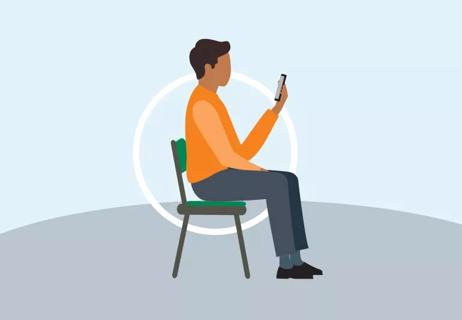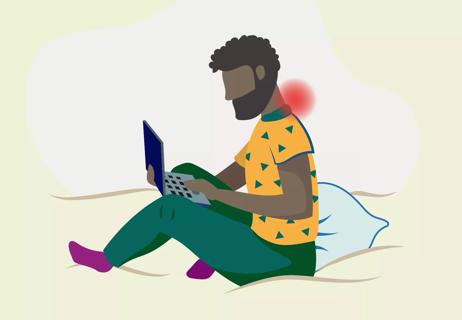You can relieve this condition by improving your posture and using a variety of movements

Who would have thought 20 years ago that we wouldn’t be able to live without a little screen in our hands?
Advertisement
Cleveland Clinic is a non-profit academic medical center. Advertising on our site helps support our mission. We do not endorse non-Cleveland Clinic products or services. Policy
Many of us know the feeling of being slumped over our smartphones and tablets — sometimes, for hours at a time. Even as we try to decrease our phone usage, those devices have become more and more woven into our personal and work lives.
Along with continual smartphone usage comes ”text neck,” a repetitive strain injury that’s being seen more regularly. Sure, it’s common for neck pain to worsen as we age. But with smartphone usage, aggravated muscle pain in the neck, shoulders and sometimes the lower back has begun to affect teens and even young kids.
So, how do we tackle this kind of neck pain? Chiropractor Andrew Bang, DC, lays out what we need to do to find relief and help prevent text neck.
Text neck is a syndrome that happens after a repeated amount of stress occurs in our neck area due to having our heads in a down-forward position.
“Think of your head like a bowling ball,” Dr. Bang illustrates. “As the ball moves forward, or it’s flexing away from your shoulders, it gets heavier.”
Three things happen when you drop your head:
This kind of consistent posture starts to affect not only your neck, but also your cervical spine, shoulder muscles and supporting ligaments.
Advertisement
Text neck can be particularly frustrating because you usually don’t feel the effects of your posture until it’s too late. “When you’re doing the action of looking down, that’s not when you feel the pain,” points out Dr. Bang. “In fact, you’re usually so engrossed in what you’re looking at that you don’t even feel the symptoms until later on. And unfortunately, it’s kind of a cumulative effect.”
The down-forward positioning of our head happens most often when you’re looking down at your phone screen or tablet, hence the nickname “text neck.”
The associated pain from this kind of stress on your neck is due to looking down at our devices for long periods of time. A few minutes here or there won’t have much effect, but Dr. Bang explains that it’s the duration of time that really starts to do a number on your spine and neck.
“If you’re scrolling for hours for a sustained period of time when you’re on TikTok, watching something on YouTube or even reading a long email, that's where the real problem comes into play,” he says.
How can using a smartphone or other mobile device cause so much hurt? It’s all in how you look at it. Literally.
“Neck muscles, in their proper position, are designed to support the weight of your head, which is about 10 to 12 pounds,” he clarifies. “But for every 15 degrees you flex your neck forward from a neutral position, the load on your neck muscles nearly doubles in weight.”
So, if you’re looking down at your smartphone with your chin near your chest, it can put about 60 pounds of force on your neck. That takes a toll.
One way to identify text neck is to take notice of any stiffness or pain you’re experiencing in your neck area. But these symptoms can also be accompanied by other issues, especially if you’re feeling more strain over time.
Text neck can lead to symptoms like:
Besides symptoms like muscle pain, text neck can cause a host of other health concerns, including finger and elbow pain. It can also lead to issues like arthritis of the neck and can even do long-term damage to your cervical spine. Sitting in a slumped position restricts your lungs’ ability to expand, impairing your lung capacity. Plus, inhaling less oxygen means your heart needs to pump harder to distribute more oxygen-carrying blood through your body.
If you’re already feeling some pain every day when you’re using your phone or computer a lot, there are ways you can find relief while you’re sitting where you are.
To find some relief for your aching text neck, try a few of these stretches and exercises:
Advertisement
Let’s focus on the part of our body that’s getting the biggest hit when we’re on our screens all day: Our necks.
“When we sit, use our computer or use our phone, our neck muscles can get overly tight,” reiterates Dr. Bang. “In some cases, they get overly stretched. So, then, some of the side and front neck muscles will get overly tight.”
Here’s what Dr. Bang recommends doing while you’re seated at work: While sitting, reach down with your right hand and hold the side of your chair. Then, lean to the left, while still holding on. You should feel a stretch on the right side of your neck. Hold for at least 30 to 60 seconds. Then, switch to the other side, grabbing the left side of your chair and leaning to the right so you feel a stretch on the left side of your neck.
Make sure you give enough time for each side. “As a rule of thumb, your stretches need to be way longer than you think they do,” notes Dr. Bang.
All while doing this, you want to keep your head looking straightforward. If you want to adjust the stretch to focus more on the front of your neck, Dr. Bang recommends repeating the stretch while looking slightly up toward the ceiling.
While some muscles can get too tight, another problem with sitting at a desk all day is that some muscles get too loose. As you’re always looking down, this is what happens to the back of your neck. “So we need to tighten it,” he explains.
Advertisement
He suggests this stretch to help: Interlace your fingers and put them behind your head. Then, push back with quite a bit of force. “Push forward with your hand and push back with your head,” he says. “This is easy to do while you’re reading an email or in a meeting.”
At this point, you should feel a good stretch in your arms, back and shoulders when you do this. “You want to push enough to get that sleepy muscle awake,” he adds.
“This is how you create variety and motion without moving much,” Dr. Bang continues. “Try this when you’re in a still position, like while you’re on a conference call or reading an email.”
If you’re feeling some growing tension in your shoulder blades while working, Dr. Bang says this is another common area that can start to feel uncomfortable. This spot is also often overstretched, rather than tight.
“That shoulder muscle is being overstretched because you're reaching your arm out and using your mouse all day and doing these micro-movements,” he says. He recommends doing a contraction stretch on your shoulder blade muscles to compensate.
To strengthen and tone this area, start out by sitting up straight with your shoulders straight, but relaxed. Then, start squeezing your shoulder blades together. Pull your shoulder blades back as far as you can, as though you’re trying to get them to touch. Contract and squeeze as much as you can. This simple stretch can alleviate stress and muscle pain.
Advertisement
Dr. Bang says to imagine that you have a pencil in between your shoulder blades as you’re doing this — you really want to focus on that area in the middle of your spine. Hold for about 30 to 60 seconds — although he says the longer you can hold it each time, the better.
Another spot that can get tight from too much desk work is your pectoral, or pec, muscles in your chest. To stretch out this area, hold the corner of your desk with your right hand and turn your body out to the left, twisting so that you’re looking over your left shoulder. You should feel this stretch in your right pec muscle. Hold for 30 to 60 seconds before switching to the other side.
Dr. Bang recommends this exercise to help stretch out your pecs and give those muscles some much-needed movement during the day.
If you’re feeling especially sore or stiff, you can combine your desk stretches with some heat or cooling therapy.When your muscles are feeling sore or tight, a bit of heat or cold therapy can sometimes be just the relief they need.
Especially when it comes to heat, Dr. Bang points out that a hot compress can help loosen up those joints that are feeling tight and stressed due to text neck. A cold compress can help target any numbness or swelling.
Beyond stretching out your aches, becoming aware of your habits is one of the best ways to prevent text neck and give your back and muscles some additional release.
“I always say, ‘motion is lotion’,” Dr. Bang shares. “Your body loves motion and your body loves a variety of motion,” he explains.
To prevent text neck, you should aim to improve your posture while also making sure your body gets plenty of movement. Dr. Bang recommends the following:
It’s good to be more mindful when staring at screens, and try and straighten out as much as possible. As Dr. Bang notes, the more you lean forward, the more strain will build up on your neck and back muscles.
You can learn proper posture and neck alignment by peeking at your profile in a mirror. If you’re standing correctly, you should be able to draw a vertical line from your ear to your shoulder.
This is why having things like a standing desk and creating an ergonomic office space can be helpful in bringing your back and neck into alignment while working in front of a screen for long periods of time.
Rather than tilting your chin down to read your smartphone, raise the device to eye level. The same goes for your desktop computer. Your monitor screen should be at eye level so your head isn’t perpetually dropping and causing muscle strain.
If you know you have to be on your phone or in front of your computer for extended periods, especially if it’s for work, it’s good to adapt an ergonomic set-up. Try a phone stand or laptop stand that elevates your screen to be at eye level.
Updating your posture is only half of the battle, though.
“The best posture is a moving posture,” states Dr. Bang. “So, yes, you can get your body in ideal postures, like when you’re sitting at your computer or having your screen at the right height. But what we really want to talk about is changing positions.”
In real-time, it could mean things like making sure you’re stretching and moving around between work and scrolling sessions. Or if you’re on your laptop, try switching it up from your lap to putting it on a table or countertop.
Switching work positions throughout the day can help you embrace movement, too. If you’re in the zone working, you can also set an alarm to remind yourself to shift positions.
You can also try a sit-stand desk. “With these, you’re allowing your body to move because you're going from a down position to an up position,” says Dr. Bang.
Speaking of alarms: Another practice is to set intentional limits on your phone usage. While it may feel like it’s close to impossible to completely limit using your smartphone, remember to take breaks or limit usage to shorter amounts of time. A good rule of thumb is to take a break every 15 to 30 minutes to help give your back and neck a break.
Got five minutes? A daily or even weekly routine can keep your body from getting too stagnant throughout the day. Try doing a five- or 10-minute session in your office as a way to reset your body from sitting in the same position. Even a quick seated yoga session can break up your screen time and do wonders to relieve future pain or stiffness.
While not part of the text neck, texting thumb is another texting-induced repetitive strain injury.
If you feel like your thumb is really feeling stiff and painful, an occupational therapist may be able to help with certain exercises, or through topical pain relievers to soothe the strained tendon.
But ideally, you should cut back on your texting if you feel like your thumb is taking a beating. Try doing a speech-to-text system where you don’t have to put staring on your hands. And if you need to write out a long essay, maybe switch to a laptop.
If you’re feeling any numbness or tingling, reach out to a healthcare provider. Being aware of any symptoms can help prevent permanent damage down the line.
There are small but meaningful things you can work into your everyday routine that can help realign your body due to text neck. But if these modifications don’t bring relief, you may need help from a chiropractor or physical therapist, especially if your pain is getting more intense.
You should talk to a healthcare provider if your neck pain isn’t going away even after you’ve made lifestyle adjustments, or if your pain is accompanied by fatigue, nausea or headaches. They can help you get the relief you need to get back to this modern world.
Learn more about our editorial process.
Advertisement

How to tell the difference

Tips for easing the tight neck muscle that tilts the head

Ease pain and stay active by keeping your spine in its proper position

Here’s why it may be happening and how you can find some relief

Stretching or applying heat and ice can provide pain relief

Foam tubes and rubber balls can help when you hurt

Neck problems can lead to head pain, but relief is possible

Here’s how working from bed impacts your health

Type 2 diabetes isn’t inevitable with these dietary changes

Applying a hot or cold compress can help with pain